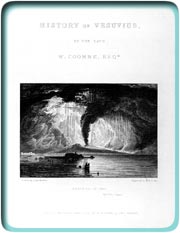






Also this issue: There's No Place Like Home Artsbeat The Magic Fire The Golden Dreydl Here's to the Ladies Hometown Phavorites Full Speed Ahead Good Boy Network |
|||||||||
November 27-December 3, 2002
art
Ashes to Ashes
 Engraving from W.B. Cooke, Eruption of 1822 (1827). |
In the years 1738 and 1748 respectively, the Greco-Roman cities of Herculaneum and Pompeii, which had been destroyed in 79 A.D. by a volcanic eruption, were rediscovered in the hills near Naples. As excavation got under way, the discoveries began to influence culture, fashion, decorative art, fine art and literature as people everywhere struggled to understand the magnitude of the disaster. This exhibition is filled with wonderful objects that inform the viewer about the disaster itself, as well as changing perceptions of the meaning of the events.
The first part of the show is called "Antiquarianism" and it highlights the 18th-century popularity of collecting artifacts. Thousands of people visited Herculaneum and Pompeii as part of the Grand Tour, and most brought back artifacts and mementos. Several items in the show were collected by Philadelphia's Logan family, including a piece of a mosaic, a box filled with ash and some pieces of broken stone objects. These humble fragments are especially poignant reminders of the passage of time. On the other end of the spectrum, the magnificent Attic Red-figure Kylix, ca. 470 B.C. -- a low vessel beautifully painted with images of a nude man, a robed woman and a lively pattern of men, weapons and horses -- played a part in history. It was excavated by Lucien Bonaparte from the grounds of his estate near Naples and given to his brother Joseph, then King of Naples. After the fall of the Napoleonic Empire, Joseph Bonaparte ended up in Philadelphia and, in 1832, gave the vessel to the American Theosophical Society.
Other pieces in the show demonstrate the impact of the artifacts on 18th- and 19th-century decorative art and the popular practice of copying artifacts. The Chiurazzi Bronzes, a group of 19th-century replicas of Greek sculptures found in the excavations, were purchased by John Wanamaker and given to the University Museum. Dancing Faun, about 2 1/2 feet tall, is a beautifully modeled, muscular nude male figure with great contrapasto. He has a swishy little tail emerging from his sacrum, small goat horns and a miniscule penis. There's also a tiny but luscious Venus and a hairy, corpulent Selenus holding an oddly anthropomorphized animal. These pieces had been in storage for many years, after tastes changed about the value of copies.
The second part of the show is called "City of the Dead" and it reveals the shifting interest during the Romantic period, away from the interpretation of the artifacts to the events and the landscape. Many splendid books and prints tell this part of the story. Some, like Mark Twain's book, The Innocents Abroad or the New Pilgrim's Progress, or Edward Bulwer Lytton's The Last Days of Pompeii recount hypothetical stories of bravery and sacrifice. Others emphasize the dramatic elements of the story with detailed representations of more recent eruptions of Vesuvius. In an early 19th-century hand-colored aquatint, The Eruption of Mount Vesuvius in 1779 by Jean-Baptiste Chapuy, cheering figures are silhouetted by the dramatic eruption, which includes sprays of sparks resembling fireworks. Similarly, a plate from an 1827 book by William Bernard Cooke, titled Pompeii Illustrated with Picturesque Views, depicts the eruption of 1822 as a cataclysmic event: churning clouds of smoke, sparks, flames and a blazing vertical column of light, effectively contrasted with a placid sea and a few sailing ships.
Just as powerfully evocative of the disaster, two engravings by Jacob Philipp Hackert, from Views of Naples published in 1777, record the beautifully rugged countryside near Naples centuries later. These prints, titled At Vietri, near Naples and At Sorriento, show cliffs with dangerously cantilevered rocks, rugged hillsides, craggy trees and pastoral scenes of animals and shepherds engulfed by the extreme wildness of nature. They are fraught with imminent disaster. These, and many of the other pieces in this thought-provoking show, point to the difficulty of resolving a catastrophe of the magnitude of the destruction of Herculaneum and Pompeii. They have an especially compelling resonance with the time in which we live now.






